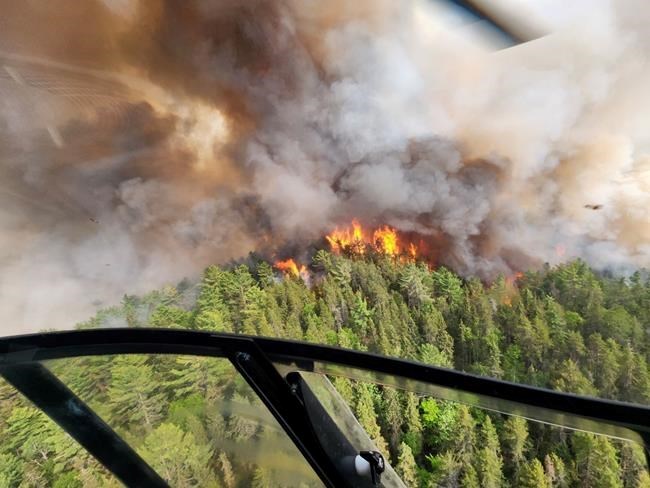Firefighters from France arrived in Canada to help Quebec face a marathon wildfire season while most evacuation orders were lifted in Nova Scotia nearly two weeks after intense infernos caused thousands to flee their homes.
Meanwhile, wildfire smoke that hung over Toronto for several days cleared Canada's most populous city Friday, but the hazy skies persisted in other parts of Ontario and Quebec and blanketed much of the west as 420 wildfires continued to burn across the country.
The arrival of firefighters from France and New Brunswick bolstered efforts in Quebec to fight 140 fires. "The sprint phase has ended and we're now in the marathon phase," said Maïté Blanchette Vézina, the province's minister of forests and natural resources.
There is expected to be about 1,200 people fighting fires in the province by Monday, including hundreds of firefighters from the United States, Portugal and Spain who were expected to arrive in the coming days.
Quebec Premier François Legault has said about 13,500 people had been forced from their homes as a result of the wildfires and though the situation is expected to remain stable over the next couple of days, it's unclear when residents will be able to return.
Officials in the United States said they are happy to help Canada but they are keeping one eye observing fire risks close to home.
"We have been fortunate to have a slow start to our fire year nationally," said Jeff Arnberger, chair of the U.S. National Interagency Fire Center's multi-agency co-ordinating group.
"However, as we head into (the) traditionally busy months of summer, we must also be prepared for wildfires in the U.S."
There are currently 345 federally co-ordinated American firefighters and support personnel in Canada but the number fluctuates as workers cycle back through the U.S. The number doesn't include state-level resources that are assisting.
The fearsome fire season slowed in Nova Scotia, where most evacuation orders were lifted on Friday.
While the largest wildfire in the province's history continued to burn out of control in Shelburne County, orders were lifted since it hadn't grown since the weekend thanks to the work of firefighters and wet, cool weather. The fire forced more than 6,000 people from their homes and destroyed 60 houses and cottages.
Evacuation orders in the Halifax Regional municipality were also lifted, with the exception of a small portion of subdivisions closest to where the fire started.
Skies cleared in Toronto but Environment Canada issued air quality statements for parts of northeastern Ontario, including North Bay, Sudbury and Timmins, as well as parts of western Quebec.
"Those places are still under smoke from the forest fires," said Gerald Cheng, a warning preparedness meteorologist with Environment and Climate Change Canada.
Cheng predicted that some smoke would move back over southern Ontario and Quebec on the weekend but at lower concentrations. Higher intensity smoke is expected north of the St. Lawrence River, he said.
Environment Canada has warned that people with lung or heart diseases, older adults, children, pregnant women and those who work outdoors are at a higher risk of experiencing health effects from the smoke.
However, the agency also noted that wildfire smoke can be harmful to everyone's health "even at low concentrations."
In Alberta, the worst air quality was near Fort Chipewyan, which was on an evacuation order as a nearby fire burned out of control. Wood Buffalo and Grande Prairie also had high-risk air quality forecasts, while Edmonton and Calgary saw moderately bad air quality.
Air quality alerts were also issued for the western half of Saskatchewan after wildfire smoke returned to that province.
In British Columbia, air quality improved almost everywhere except for areas around Fort Nelson, Stone Mountain Park, Williston and the Peace River district.
Forecasters said showers on Saturday could sprinkle an aggressive wildfire that forced more than 2,000 people from their homes in northeastern B.C., but thunderstorms could sweep the region before any rain arrives. That could complicate efforts to fight the West Kiskatinaw River wildfire, which has burned 96 square kilometres in the three days since being discovered.
Premier David Eby said B.C. residents need to be careful not just in the backcountry, but in any forested area, as the province faces the potential for significant wildfire activity this summer.
"Right now, conditions are very dry and we expect that to continue," Eby said.
"Please use caution, so that we can try our best to avoid a catastrophic fire season."
More than 43,000 square kilometres have burned in Canada so far this year, making 2023 the second-worst year for fires on record. That's before the hottest months of the year have even begun.
In 1995, 71,000 square kilometres burned, the most ever in a single year. The pace of burning at the moment has Canada on track to surpass that total before the end of June.
This report by The Canadian Press was first published June 9, 2023.
The Canadian Press
Note to readers: This is a corrected story. A previous version said the largest area burned from wildfires in Canada in 2014.



